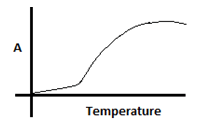This set of Class 11 Physics Chapter 11 Multiple Choice Questions & Answers (MCQs) focuses on “Thermal Expansion”.
1. It is possible that with decrease in temperature volume may increase. True or False?
a) True
b) False
View Answer
Explanation: Usually with increase in temperature volume increases. But water shows anomalous behaviour when cooled from 4℃ to 0℃. Its volume increases when it is cooled from 4℃ to 0℃, while one would expect volume to decrease with decrease in temperature.
2. The value of coefficient of thermal expansion is always the same for a material. True or False?
a) True
b) False
View Answer
Explanation: The coefficient of thermal expansion is constant over a range of temperature, but is not always constant. It depends on temperature. For eg: the graph of coefficient of volume expansion of copper with temperature is shown below.

3. What is the value of coefficient of volume expansion for an ideal gas?
a) (ΔV/V)/Δ T
b) 2*coefficient of linear expansion
c) 1/3 * coefficient of linear expansion
d) (V/ΔV)/ Δ T
View Answer
Explanation: ΔV/V = α*ΔT ⇒ α = (ΔV/V)/ΔT. Note that the coefficient of volume expansion is 3 times the coefficient of linear expansion.
4. What is the relation between coefficient of area expansion(A) and coefficient of volume expansion(B)?
a) B = 1.5A
b) A = 1.5B
c) A = 3B
d) B = 3A
View Answer
Explanation: Let the coefficient of linear expansion be α. The coefficient of area expansion is 2α and the coefficient of volume expansion is 3α. ∴ The coefficient of volume expansion is 1.5 times the coefficient of area expansion ∴ B=1.5A.
5. A rod is lying on the ground with both ends free. It has a length of 1m. Coefficient of linear expansion equal to 1.1*10-5per °C. Calculate the strain when the change in temperature is 10K.
a) 11*10-5
b) 1.1*10-5
c) 0
d) 311.3*10-5
View Answer
Explanation: When the rod is heated it permanently increases in length. As there is no force holding it in its initial length from either side, there will be no internal forces to produce strain.
6. What is the value of coefficient of area expansion for a sphere? Assume coefficient of linear expansion is α.
a) 2α
b) α
c) 3α
d) α/2
View Answer
Explanation: The area(A) of a sphere is 4πr2. When the temperature increases by ΔT, let change in area be dA. Let the radius increase by dr. The coefficient of area expansion is (dA/A)/ΔT.
∴ dA = 4π(r – dr)2– 4πr2 ≅ 8πrdr.
Also, dr = rαΔT.
The coefficient of area expansion is (dA/A)/ΔT
= (8πr*rαΔT/4π) / ΔT
= 2α.
7. A uniform metal sheet has a hole in its centre. What happens to hole when the sheet is uniformly heated?
a) Its size increases
b) Its size decreases
c) It changes shape
d) Remains the same size
View Answer
Explanation: The hole’s circumference is made of metal. When the sheet is heated this circular circumference will expand and therefore the size of hole will increase. The hole will not get deformed as the sheet is uniform in all directions from the centre of hole and is also heated uniformly.
8. What is the unit of coefficient of area expansion?
a) per °C
b) °C
c) per (°C)2
d) (°C)2
View Answer
Explanation: The coefficient of area expansion is defined as (ΔA/A)/ΔT. So we see that its unit is per °C. Note that all the coefficients of thermal expansion, namely linear, area & volume have the same unit.
9. A rod having α = 1*10-5per °C and length of 70cm has one of its end rigidly connected to another rod of length 1m and α= 0.5*10-5per °C. Find the new length of the two joined rods when their temperature is increased by 30℃.
a) 170.021cm
b) 169.021cm
c) 171.031cm
d) 170.031cm
View Answer
Explanation: The new length of first rod: I1 = 70(1+1*10-5*30) = 70.021cm
Similarly I2 = 100(1+ 0.5*10-5*30) = 100.015cm Therefore, new length = 70.021 + 100.015
= 170.036cm.
10. Two strips of equal volume and length are joined together as shown in the diagram. What will happen when they are heated? Assume that the thermal coefficient of expansion of 1 is greater than that of 2.

a) Increase in length will be equal for both
b) Bend with 1 on convex side
c) Break rather than change length
d) Bend with 2 on convex side
View Answer
Explanation: When the rods are heated, both will have different increases in length as they have different thermal coefficients of expansion. In order for this to be achieved the rods will have to bend so that the one having higher thermal coefficient of expansion can be on the convex side as the length of convex side will be greater than that of concave side.

Sanfoundry Global Education & Learning Series – Physics – Class 11.
To practice all chapters and topics of class 11 Physics, here is complete set of 1000+ Multiple Choice Questions and Answers.
If you find a mistake in question / option / answer, kindly take a screenshot and email to [email protected]
- Practice Class 11 - Biology MCQs
- Practice Class 11 - Chemistry MCQs
- Practice Class 12 - Physics MCQs
- Practice Class 11 - Mathematics MCQs
- Check Class 11 - Physics Books
